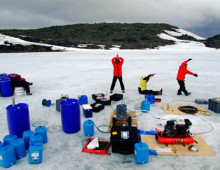Populus is one of the flagship plant genomes sequenced by the DOE JGI, and it is of central importance in DOE-funded sustainable biofuels initiatives. One of the primary factors limiting genetic improvement of Populus is a poor understanding of reproductive development, which is essential both for traditional breeding as well as transgenic biosafety. Salix is…
Microbes metabolizing methane in Lake Washington
Metabolism of methane is an important part of the global carbon cycle. Methane is also recognized as one of the major contributors to the greenhouse effect, with its atmospheric concentration steadily increasing. Freshwater lakes are environments characterized by dynamic cycling of methane, serving both as major sources and major sinks. To better understand the methane…
Baselining Antarctic microbial communities
There is clear recognition that climate change is impacting all life on Earth, particularly in polar environments. For this project, the team focuses on determining how microbial communities change throughout a complete annual cycle in three climate-sensitive, marine-derived Antarctic lakes (Ace Lake, Organic Lake and Deep Lake), and a near-shore marine site. The project will…
Carbon cycling in Delaware Bay estuary
This project seeks to examine carbon cycling mechanisms of active bacteria in the freshwater to marine transition zone of Delaware Bay, one of the nation’s largest estuaries. To learn how the microbial community changes over space and time, the team will study samples collected from trips taken at different times throughout the year. Researchers want…
Microbial composition of tropical peatlands
Peatlands are hotspots of soil organic carbon (SOC) accumulation, and also sites where microbial respiration plays a major role in carbon storage and cycling. Though many think of peatlands in northern regions, there are peatlands in the tropics such as Southeast Asia and the Amazon. Tropical peatlands are estimated to store 11-14 percent of global…
Plant-endophyte-pathogen interactions using poplar
Within leaves, disease-causing pathogens co-occur and interact with ubiquitous, non-pathogenic symbionts known as endophytes. Understanding the role of fungal endophytes in diseases of crop-, plantation-, and forest plants is of great interest as researchers strive to meet current and future demands for food and bioenergy while maintaining functional and biologically diverse ecosystems. This project focuses…
Lignocellulose-degrading Agaricales fungi
This project focuses on the genomes of thirty-two saprobic Agaricales, for a large repertoire of enzymes acting on plant biomass.
Insights on tree-subsurface microbial interactions
In forested watersheds, trees are center stage in the carbon cycle. However, tree-based photosynthetic carbon fixation is modulated by interactions with the subsurface microbial biosphere. Previous studies focused on the root rhizosphere, but recent work at the Eel River Critical Zone Observatory (CZO) in Northern California suggests much of the carbon, water and nutrient exchange…
Subsurface microbiology for GEWaSC modelling
Investigating the ways in which intersecting biological, chemical, and physical processes shape the terrestrial subsurface, with feedbacks to the regional or global system.
An ENCODE-like model for Chlamy
The objective of this project is to to perform a comprehensive study of regulatory (transcriptional and miRNA) networks underlying the nutrient stress-induced lipid accumulation response. They intend to use the information to develop an ENCODE-like working model of DNA regulatory elements associated with nutrient-responsive control of lipid accumulation phenotype (LAP) and biomass production in Chlamydomonas…


